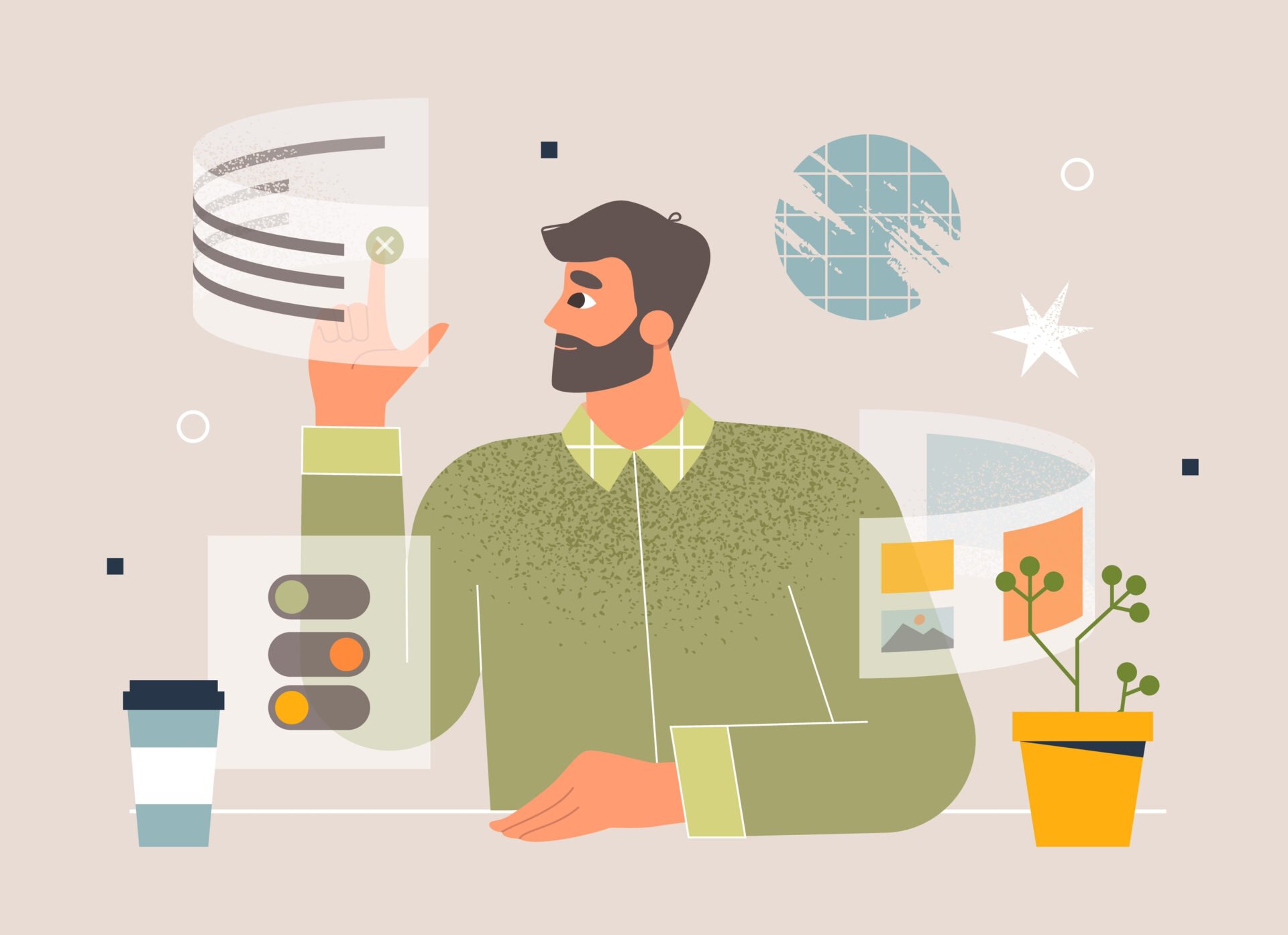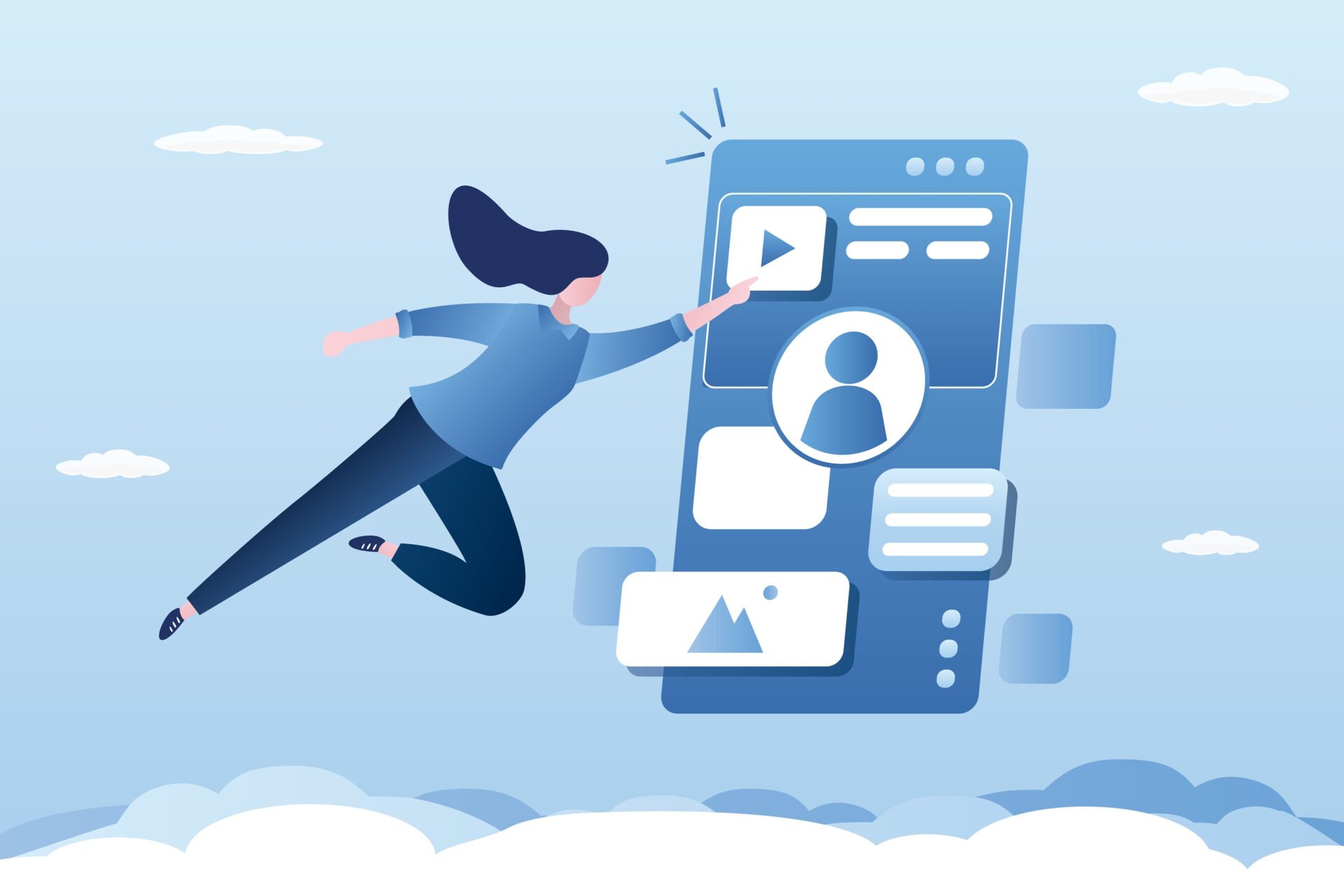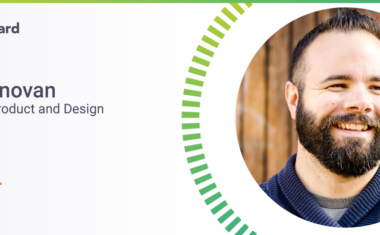32 UI Interview Questions and Answers [2023 Prep Guide]

In this article
If you’ve breezed through a recruiter phone screening, wowed a hiring manager with your UI design portfolio, and proven your technical skills in a design challenge, then you’ve likely arrived at one of the final stages of the user interface design job interview process—the interview loop.
Depending on the organization, a job interview for a user interface designer can involve as few as one hiring manager, or become an intensive process with designers, managers, and executives from different teams. The goal tends to be universal, though—to get to know you as a person and a designer; to ascertain your passion and drive, and to understand how you might fit in with an existing team.
With that in mind, below are some of the most common UI design interview questions that are asked during candidate screenings.
Entry Level UI Interview Questions
Wondering where to start with your UI interview preparation? Brush up by exploring answers to these foundational questions.
Why Do You Want To Become a UI Designer?
Employers want to know what drives YOU and how these motivations will add value to their organization. In lieu of waxing poetic about your passion for UI, get specific about your career goals—and illustrate how these goals align with the mission, values, and business objectives of your potential employer. Highlight the ways that your skills and career motivations match up with the requirements of the role you’re applying for as well as the company’s broader needs.
What Does a UI Designer Do?
This commonly asked question attempts to reveal two things:
1) What do you understand about the roles and responsibilities of a UI designer, and
2) How do you think about the role of UI design in the broader design process.
Instead of reciting a definition of a UI designer, take the opportunity to show that you understand how strong UI design ultimately serves the user, how it falls at the intersection of user experience and graphic design, and the multidisciplinary nature of the job.
What Are the Most Required UI Skills?

Use this question to convey your knowledge and mastery of core UI concepts and practices. Visual communication skills are a must, so highlight your ability to guide users with imagery, interactive elements, and more. Demonstrate your understanding of color theory, typography, and UI design patterns as well as big-picture processes like design thinking. Prototyping is a vital skill for UI designers, so don’t forget to mention proficiency with key prototyping tools like Sketch, Adobe XD, or InVision.
How Did You Get Started in Creating User Interfaces?
One way to think of this question is as an invitation to show your passion for the craft. Instead of giving the interviewer your life story, come prepared with a story about what drew you to UI design in the first place, how your background might have informed your interest, and whether there are any case studies that are particularly illustrative of what drives you as a designer. Remember: although there is no wrong answer to this type of question, the strongest answers show the recruiter that you have the creativity, problem-solving skills, and motivation to be a valuable addition to the organization.
What Design Process Do You Follow and How Do You Validate Your Decisions?
A strong case study is crucial to successfully answering this question. Think of a project you’ve worked on (it might be the same as the one used to answer the previous question) and walk the interviewer through each step of the UI/UX design process. Some of the questions you might try to answer include how you incorporated user research and usability testing into your designs, what you learned from design trends, how each step—from the initial wireframes, mockups, personas, and information architecture to prototypes and the final layout—informed the next, and how you developed an understanding of the user experience along the way. Your response should show the interviewer that your choices were well-informed and deliberate.
When Planning the Design Layout, What Parameters Do You Consider? Do You Have a Design Checklist?
Help interviewers envision you as an employee by offering a window into your design process. This is an opportunity to showcase your approach to a foundational design task while spotlighting your ability to apply conceptual knowledge in a hands-on scenario. A successful layout will present information in a way that helps users seamlessly achieve their goals.
To design an effective layout, you’ll need to consider key parameters like information hierarchy, the size and type of device through which users will access the product, and the ways in which users will interact with the product. You’ll also need to consider default layouts that users already know—familiarity reduces friction. A design checklist will help you optimize your layout by directing your attention to the efficacy of core design features like:
- Typography. The goal is readability. Consider line height, uppercase tracking, font style, font weight, text contrast.
- Spacing and Margins. Use padding to clarify relationships between UI elements and introduce information gradually to prevent overwhelm.
- Imagery and color. A cohesive look is key for brand recognition. Use iconography with consistent line widths, weights, sizes, and colors. Stick to your color palette. Image sizes should be cohesive.
- UI elements. Reuse UI elements. Check how all UI elements are displayed on screens of different sizes and how they respond to various orientations. Ensure interactive elements function correctly.
What Are Some of the Biggest Design Challenges You’ve Encountered?

This is one of the more important UI design interview questions because it’s a chance for you to show that you can reflect and think critically about your own experiences, clearly articulate challenges you’ve faced as a designer, and talk about the problem-solving skills you’ve employed. This is not the time to complain about a former job, difficult coworkers, or demanding clients; instead, think of these challenges in a constructive way. What did you learn from these experiences? How might these challenges have prepared you for the role you’re currently applying for?
What Do You Think About Changing Design Trends? How Do You Keep Up?
Because UI design is an emerging field, employers are looking for candidates who keep up with—and think critically about—industry trends. Pick one or two new trends and explain why they work (or don’t) from a user experience standpoint. For example, if you see promise in the rising tide of emotive interaction design, be prepared to discuss how building experiences that mimic human interaction stimulate emotive connections that improve user experience.
To show that you keep a finger on the pulse of UI design trends, tip your hat to podcasts like UI Breakfast and Design Matters. Engaging on social media with UI thought leaders like Jared Spool, Aaron Walter, and Katie Dill is also an effective way to stay up-to-date on all things UI.
Do UI Designers Need UX Design Knowledge?

In a word, yes. As a UI designer, you’ll work closely with UX designers over the course of the product development lifecycle. Showcase your UX design knowledge to assure potential employers of your capacity to collaborate seamlessly with teammates. UX knowledge will also inform your design choices and help you better understand project workflow and products overall.
Advanced UI Interview Questions
As your interview process progresses, you will encounter increasingly complex UI designer interview questions. Read on to find out what to expect.
Why Is UI Vital for Any Business?
This question is designed to evaluate your awareness of the business value of UI design. Technical skills alone aren’t enough—employers seek candidates who understand how their role fits into the organization’s broader objectives. Excellent UI design delivers a frictionless and enjoyable experience that facilitates business growth, so discuss how successful UI can help an organization expand its customer base, serve as a brand differentiator, increase engagement and retention, boost conversion rates, and foster brand loyalty.
How Do You Explain the Best/Ideal UI Design?

Use your answer to demonstrate your knowledge of UI best practices. Great UI design puts users in control and can accommodate diverse abilities, varying skill levels, and different amounts of product knowledge to create frictionless, pleasurable interactions. Ideal UI design reduces the cognitive load on users and offers visually and functionally consistent interfaces to ease user learning curves.
Give an Example of an App That You Think Has a Strong UI Design. What Do You Think It Does Well?
This is an opportunity for you to talk about your taste and design values—identify sources of inspiration, draw connections between the strengths of a design and how they might affect the user, and highlight elements such as graphics, buttons, fonts, and color that you believe contribute to a website or platform’s usability, accessibility, and desirability. Remember: this question isn’t just about your taste in design—recruiters are also looking to see if you understand how design decisions affect the user experience. Point to examples like Pinterest’s waterfall flow card design, which improves visibility and creates a more “clickable” product—or Figma’s animated tooltip pop-ups, which enhance usability for beginner users.
What App Do You Think Has a Weak User Interface? Why?

Similar to the previous question, this question gives you room to talk about your design values. But it also offers an opportunity to critique a weak UI, which by extension lets you demonstrate your ability to clearly articulate what isn’t working and why, and how you might give feedback to a team member. It’s also a chance to showcase your creativity by offering possible solutions to improve the UI. An example of a weak user interface might be the excessively cluttered UI of Apple’s now-defunct iTunes—also known as “Apple’s most hated app.”
Describe What a UI Design Failure Might Look Like on a Newly Launched Product?
UI design failures create friction and frustration for users. Design flaws might stem from prioritizing innovation over usability, lack of accessibility, or other variables—but no matter what example you choose, be sure to explain why the issue fails to meet a key user need. Your response should show both attention to detail and an aptitude for problem-solving. Consider what changes you would make to address the pain point and prepare to explain why those changes would be effective.
What Is the Design Thinking Process?

Design thinking is an iterative process that centers users—so do just that in your response. Instead of simply rattling off the steps of the process in chronological order, highlighting how each phase revolves is anchored by the user. The process involves five steps:
- Empathize. Absorb user perspectives to discover user motivations and experiences.
- Define. Articulate the user problem. Uncover hidden user needs through user research.
- Ideate. Let go of limits to generate a variety of possible solutions to the user’s problem.
- Prototype. Build a small-scale version of the product to target specific user issues.
- Test. Have users create data to find out what needs to be changed or refined.
Employers are looking for a response that conveys your understanding of design thinking as a collaborative and human-centered process.
Get To Know Other Design Students
Janessa Poole
Content Designer at Reforge
April Hoang
UX Designer at Microsoft
Sadie Rubio
UX Designer And Researcher at Lumea
Which UI Design Tools Are Prominently Used Among UI Designers? Why Is Sketch Garnering Popularity?
Rapid innovation dominates the landscape of UI design, and employers want to hire candidates who are able to capitalize on and extract maximum value from standard and emerging tools. This question is also an opportunity to show that you understand the features that top tools bring to the table in the context of different deliverables.
As an in-browser tool, Figma boasts real-time collaboration capabilities—making it ideal for remote, team-based projects. AdobeXD and InVision are excellent for producing high-fidelity, interactive prototypes. The popularity of Sketch is growing thanks to its simple interface, advanced native design capabilities, variety of third-party plugins, complete toolkit functionality, and constant updates.
What Are the Principles of User Interface Design?
The core principles of user interface design revolve around—you guessed it—usability. They include:
- Clarity. Key information should be easily recognizable and prioritized according to importance.
- Simplicity. Streamline tasks and communicate instructions in a straightforward, unambiguous way. Visibility: Steps to complete a task should be obvious, with minimal distractions.
- Communication. Feedback should keep users informed of changes, errors, successes, and required actions.
- Tolerance. Flexibility should seamlessly accommodate user errors and allow users to remedy mistakes.
- Consistency. Reuse components and actions to reduce the cognitive burden on users.
Be prepared to explain how you’ve applied these principles in your previous work.
Explain the Design Language System (DLS).

A design language system (DLS) is a set of standardized guidelines that maintain consistency across products within a brand ecosystem. A DLS framework should include reusable components, design standards, and documentation of past UI audits. Other core features include style guides, pattern libraries, and inventories of tools used throughout a project.
How Do You Revamp/Redesign an Existing Product/Website? Explain the Steps Involved.
Show employers how you’ll tackle this common task by breaking down your process. First, you’ll need to audit the website’s assets and analyze your competitors. Next, you’ll want to define your target audience and update user personas if that audience has changed. You’ll also need to evaluate current product performance and select the metrics you’d like to improve. This will inform your list of desired changes. After making changes, you’ll need to test (and probably iterate) in order to achieve your desired results.
Explain Usability Testing?

Usability testing is a crucial part of the design process in which designers observe how actual users interact with a product. Usability testing seeks to evaluate product functionality and reveal pain points that successive iterations of the product must address.
What Are Various UI Frameworks?
UI frameworks are software suites that allow designers to create UI components or modify interfaces with APIs. Thanks to UI frameworks like Bootstrap, Semantic UI, Foundation, and Pure.css, designers can create beautiful applications without the command of a front-end language like Javascript.
What Do You Mean by Semantic HTML?

Semantic HTML tags are used to mark up web pages in a way that reinforces the meaning, structure, and organization of a web page’s content. Properly implemented semantic tags increase a page’s readability for both computers and human users and improve user experience by heightening accessibility. Increased readability also benefits a web page’s SEO ranking.
How Do You Differentiate Between XHTML, HTML4, and HTML5?
These markup languages are used to build websites and applications. HTML5 is a newer, more mobile-friendly version of HTML4, which remains comparatively more compatible with browsers. HTML5 semantic tags like footer, header, nav, and section, are not supported by HTML4-based browsers. However, HTML5 offers new features like video playback and drag-and-drop that HTML4 could only support via third-party plugins.
Prior to the debut of HTML5, the World Wide Web Consortium created XHTML as an HTML extension based on the XML format. XHTML is similar to HTML4 but has stricter rules and requirements regarding tags, parsing, and more.
How Does a User Interact With a Product?

Users interact with a product via language and visuals as well as through more complex design dimensions including the space in which the interaction unfolds, objects like laptops and tablets through which the user accesses the product, and page load time (watch out for unnecessary widgets) plus the amount time the user spends completing the interaction. An excellent design accounts for each dimension of user interaction.
General UI Interview Questions & Answers
These UI developer interview questions give interviewers a sense of your personality and your command of vital soft skills.
Introduce Yourself
This is your chance to tell your UI story. This narrative should concisely explain your path as a UI developer and illustrate how the skills you’ve built over the course of your journey will make you a valuable asset in the role you’re applying for. Highlight the ways in which you mesh with company culture, and showcase how your current and future goals as a designer dovetail with the organization’s values and business objectives.
What Do You Know About the User Interface?

A user interface is a point where a user interacts with a device, website, or application. Effective user interfaces are responsive, accessible, intuitive, and enjoyable to use—but above all, they exist to solve a user problem. When answering this question, emphasize the purpose of well-crafted user interfaces and the business value they provide.
What’s an Example of a Design Problem You’ve Solved?
Similar to the previous interview question, this question allows you to focus on how you overcame a design problem by discussing your interaction design skills and capabilities, how you were a team player (if applicable), and any soft skills you used to solve the problem. It’s worth thinking of a favorite project you’ve worked on and the various design disciplines that you had to draw on—what kinds of user testing and research methodologies did you use? How did you foreground user-centricity? What teams and stakeholders did you have to work with and how did you manage to satisfy their needs?
What Is the Most Challenging UI Project You Encountered on Your Learning Journey?
Go ahead and brag—you’ve earned it! Your answer to this question should also showcase your communication skills and ability to craft a narrative. For best results, recount your experience using the STAR method. First, describe the situation and contextualize the challenge. Next, explain the task you had to complete. Then articulate the actions you took to complete the task. Finally, summarize the results and what you learned from the experience.
A Situational Question Based on Your Resume.
Interviewers ask situational questions to assess how you respond to common workplace challenges. Sometimes, interviewers may base these situational questions on the previous work experiences listed on your resume. Examples might include:
- Tell me about an instance in which stakeholders created obstacles during product development. How did you overcome those obstacles?
- Was there a time you disagreed about the design of a product feature with a teammate? How did you find a solution?
Try using the STAR method to craft concise narratives that frame your involvement in a positive light.
How Do You Handle Criticism?

Recruiters asking this question want to know that any candidate they allow through to the next round will be collegial, cooperative, and responsive to feedback. When responding, it’s worth highlighting an instance when you received negative feedback on a UI project and how you were able to approach that criticism in a constructive way. Did you have a meeting with a manager to get a better understanding of the criticism? Were you open to collaboration to strengthen your work? Did you use the critique as an opportunity to push yourself and/or learn? All designers will have their work critiqued at some point, so it’s important to show that you are committed to improving a situation.
Why Do UI Designers Work With UX Designers?
Collaboration between UI and UX designers is crucial to product success. UX designers architect user experiences while UI designers communicate those experiences in ways that users will enjoy. The work of UX designers ensures that a product’s structure benefits users—but the work of UI designers ensures that a product’s structure is presented effectively.
How Would You Collaborate and Work With UX Designers?

Broadly speaking, you will collaborate with UX designers throughout the design process as part of the greater UI/UX feedback loop—UI designers create interfaces based on user research and architectures developed by UX designers, who test prototypes to gather insights that UI designers will incorporate in later iterations. You can also offer up a tangible example like a style guide, a project you would work on with a UX designer to streamline the consistency, aesthetic, and functionality of products.
UI Design Career FAQs
Wondering if a UI design career is right for you? Check out these answers to frequently asked questions about UI design.
Is UI Design a Good Career?
UI design is a collaborative, creative profession that offers numerous opportunities to shape the digital world. Growing demand for web accessibility means that UI designers also have the chance to create positive social impact—and career opportunities are on the rise. In fact, LinkedIn named UI design as one of the top 15 most in-demand professions of 2021. UI designers are well-compensated, earning an average annual salary of $77,01.
How Do You Prepare for a UI Interview?
Reflect on your strengths and goals in order to define your identity as a UI designer. This will help you articulate the value you’ll bring to a role. Next, research the company you hope to work for and figure out how your skills will help them succeed. Finally, be sure to review your portfolio and prepare to discuss prior projects in a way that highlights your talents and unique areas of expertise.
How Should You Answer “Why Should We Hire You as a UI Designer?” During an Interview?
Interviewers want to know why you are a match for this particular company. An effective answer will demonstrate a thorough understanding of company culture and will spotlight the ways in which your values and goals are in alignment with those of the organization. This is also an opportunity to emphasize your value-add, so think about how your skills might alleviate a current pain point for your employer.
What Are the Growth Opportunities in UI Design?
Organizations across industries are scrambling to stand out and stay competitive in a digital world—which has created many exciting opportunities for career growth in UI design. UI design skills could lead to design roles that focus on emerging technologies like VR—or could facilitate a pivot into related roles like product designer or front-end developer. Those who want to explore back-end development could start by learning a programming language like Java. Finally, with the right leadership skills, you’ll also be able to advance into managerial or directorial roles.
Since you’re here…
Not sure where you’ll find the time to learn UX and UI skills? We’re here to help. Our fully flexible UI/UX Design Bootcamp takes just 12-15 hours a week over 6 months and is proven to increase student salaries by $25,033 on average per annum. We’ve helped over 10,000 students make the switch without quitting their day jobs – shouldn’t you be next? Jump in today with our free design fundamentals course.





